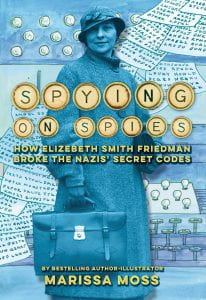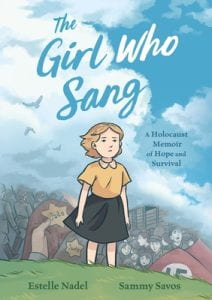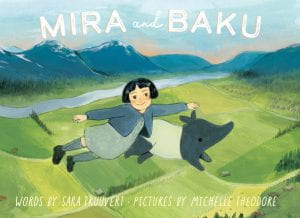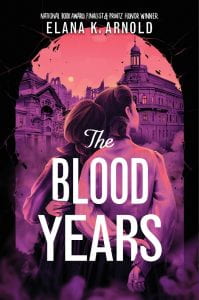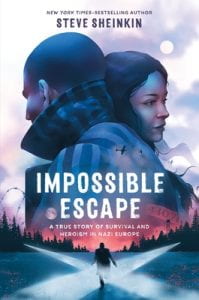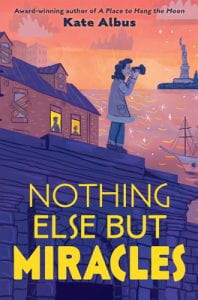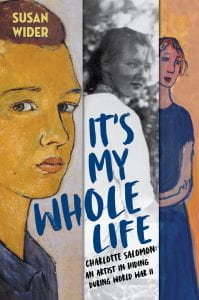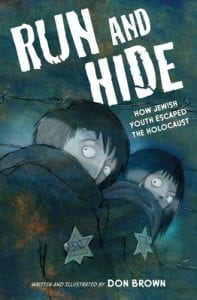 Brown, Don. Run and Hide: How Jewish Youth Escaped the Holocaust. Clarion Books, 2023. 978-0-35-853816-5. 190 p. $22.99. Grades 7-12.
Brown, Don. Run and Hide: How Jewish Youth Escaped the Holocaust. Clarion Books, 2023. 978-0-35-853816-5. 190 p. $22.99. Grades 7-12.
Run and Hide details Hitler’s rise to power in Germany and describes how Nazi Germany’s expansion of power led to prejudice, violence, and murder against the Jewish population in Europe. Don Brown focuses the majority of this graphic nonfiction title on real stories of children’s survival during the Holocaust. Brown includes information about the Kindertransport that took place prior to the Nazi invasion of Poland. The train-based evacuation of children ran from Europe to England and saved 10,000 children. Other resistance groups and miraculous stories of neighbors hiding children throughout the war are also covered.
THOUGHTS: This newest graphic nonfiction release by Don Brown is descriptive and honest. It is an excellent resource for secondary students to understand the origins of the Holocaust and what it was like to be a child (or parent) living in fear during this time. Brown shares amazing stories of survival here, but importantly, he also explains the stories he includes were statistically exceptional to the million children who did not escape. The instances of survival included in Run and Hide were only able to occur through a combination of “near misses, tight squeezes, dicey chances, long odds, and dumb luck.” The focus of this story is on survival and hiding rather than the details of life in concentration camps; in this way, the reader is spared the most brutal details and images of the Holocaust. Brown’s extensive bibliography is both necessary and helpful for students who are interested in learning about his source material. Mentions of other and ongoing instances of genocide are also included in the author’s note. Brown’s drawings enhance the tone of the text. Recommended for middle and high school graphic nonfiction collections.
Graphic Novel
In his latest graphic history for young readers, author and illustrator Don Brown explores the history of World War II with a focus on the plight of young Jewish people and heroic efforts to save them. Brown has chronicled other disasters, both natural and manmade, in his previous works: 9/11, Hurricane Katrina, the Dust Bowl, and the flu of 1918, among others. His text and artwork are particularly urgent in Run and Hide, perhaps because – as he writes in his author’s note, appropriately titled “Uninterrupted” – “Hate and violence endure, uninterrupted” (179). Here he covers Kristallnacht, the Kindertransport, the “final solution,” deportations, and more. In depicting each event, he incorporates first-person testimony in speech bubbles. This technique succeeds in both portraying and personalizing the complex events of the Holocaust. His grim, roughly drawn line art of concentration camps are especially effective. Throughout Run and Hide, Brown credits the bravery of Jewish youths and the heroic actions of resistance networks but also leaves the reader with the stark fact that one million children were killed in Europe during WWII.
THOUGHTS: Run and Hide is a remarkable work of graphic nonfiction. It presents our most difficult history in an approachable way that will inspire deeper research and action. (Thorough source notes and an extensive Bibliography are included.)
Graphic Novel (Nonfiction)
950.43 World War II
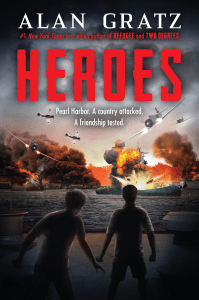 Gratz, Alan. Heroes. Scholastic Press, 2024. 978-1-338-73607-6. $14.30. 272 p. Grades 5-8.
Gratz, Alan. Heroes. Scholastic Press, 2024. 978-1-338-73607-6. $14.30. 272 p. Grades 5-8.
